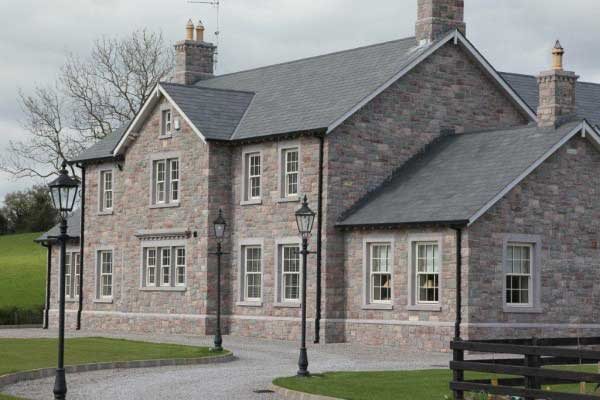
As you may be noticing, the days are growing shorter and the air is turning colder, which means it’s time to start thinking about preparing your property for the winter season. A well-prepared property not only ensures your comfort but also helps you save on energy bills and prevents potential issues that could arise during the cold months.
Let’s walk you through the essential steps to get your home ready for winter, from insulation upgrades to security measures. Let’s dive in and make sure your property is winter-ready.
Windows are one of the primary areas where heat can escape and cold air can enter. Before winter arrives, perform a thorough inspection of your windows to identify any drafts or gaps that could compromise your home’s warmth. Seal these areas using weatherstripping or caulk to prevent cold air from entering and warm air from escaping.
Consider taking your window upgrades a step further by investing in energy-efficient double-glazed or even triple-glazed windows. These advanced window systems are designed to provide superior insulation, reducing heat transfer and noise infiltration. Once you upgrade your windows, you not only enhance your home’s thermal performance but also potentially lower your heating bills in the long run.
Proper roof insulation is crucial for retaining heat in your home. Begin by inspecting your attic or loft insulation. Ensure that the existing insulation is in good condition and adequately covers the entire space. If you find any gaps or areas with insufficient insulation, consider adding more insulation material to bolster your home’s thermal performance.
Wall insulation is another important factor in maintaining a warm indoor environment. If your property has cavity walls, consider having them insulated to prevent heat from escaping. Cavity wall insulation involves injecting insulation material into the gap between the inner and outer walls of your home. This process creates a thermal barrier, significantly reducing heat transfer through the walls.
Cold floors can make your home uncomfortable during winter. Check your floor insulation and, if necessary, add rugs or carpets to help retain heat. To combat this issue, inspect your floor insulation and ensure it’s in good condition. If necessary, add rugs or carpets to specific areas to help retain heat and provide a cozy underfoot experience.
Schedule a professional boiler inspection to ensure it’s in good working condition. A well-maintained boiler operates more efficiently and can save you money on heating bills.
Bleed your radiators to remove trapped air, ensuring they heat up evenly. This simple task can improve the efficiency of your heating system.
Consider installing a smart thermostat that allows you to control your heating remotely and create heating schedules based on your daily routine. This can help optimize energy usage.
If possible, divide your home into heating zones and control them independently. This way, you can heat only the areas you’re using, saving energy and money.
Install draft excluders on doors to prevent cold air from entering your home. You can also use draught excluder strips around windows and letterboxes.
Invest in thick, insulated curtains to keep the cold out and the warmth in. Close them in the evenings to trap heat.
Inspect your property for gaps and cracks in walls, floors, and ceilings. Seal them with caulk or expanding foam to prevent heat loss.
Ensure your roof is in good condition. Replace damaged or missing roof tiles to prevent leaks and drafts.
If you have a working fireplace or wood-burning stove, have your chimney cleaned and inspected by a professional to prevent chimney fires.
Install carbon monoxide detectors near your heating appliances to detect any leaks. Check batteries regularly.
As the nights get longer, consider upgrading your home security with motion-activated lighting, CCTV systems, or smart security devices.
Prepare an emergency kit with essentials like flashlights, blankets, non-perishable food, and a first-aid kit in case of power outages or severe weather.
Trim overhanging branches and clear your garden of debris to prevent damage to your property during storms.
When winter’s icy grip takes hold, it can wreak havoc on outdoor faucets. Freezing temperatures can cause the water inside these fixtures to expand, potentially leading to burst pipes and water damage. To safeguard against this costly and inconvenient problem, faucet insulation is your go-to solution.
Start by thoroughly cleaning your gutters to remove any leaves, debris, or buildup that could obstruct the flow of water. Clogged gutters can cause water to pool, leading to ice dams and potential roof damage. A clean gutter system allows melting snow and rain to flow freely, reducing the risk of ice-related issues.
For properties with outdoor boilerhouses or exposed pipes, winter’s freezing temperatures pose a significant threat. Frozen pipes can disrupt your heating system, leading to inconvenience and costly repairs. To mitigate this risk, insulating your boilerhouse and exposed pipes is a prudent measure.
With these seasonal preparations, your property will be well-equipped to handle the challenges of winter. Not only will you enjoy a warm and comfortable home, but you’ll also save on energy bills and minimise the risk of cold-weather-related issues.
If you need assistance with any home improvement projects, including window and door upgrades, insulation, or security enhancements, contact Hanley Trade Frames. Our team of experts is ready to help you make your property winter-ready.
Get in touch with us today for a free quote and personalised advice on improving your property’s energy efficiency and comfort. Reach out to us via our online contact form or call 01782 201 150, and let’s get started on your winter preparations.